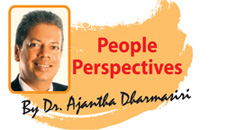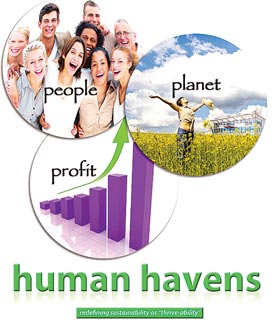Future of HR: Be lean, seen and green
 Human Resource has always been an evolving function. It not only
focuses on the most precious resource in any organisation but also
ensures the presence of competencies for competitive advantage. Human Resource has always been an evolving function. It not only
focuses on the most precious resource in any organisation but also
ensures the presence of competencies for competitive advantage.
As much as it had in the past and the present, the function of HR
will have many challenges in the future. Today's column discusses three
global trends with respect to future HR. I call them the challenge to be
lean, seen and green.
Be lean
There is a wave of becoming faster, cheaper, better in an
increasingly competitive global scene. HR cannot avoid its influence.
Stemming from the Japanese concept of creating value by eliminating
waste, lean management has spread its wings to cover the manufacturing
and service sectors.
Gone are the days when HR was 'humanly rich' as a department with all
sorts of people, mostly dumped by the seniors. Efficiency with regard to
optimising cadre, in clearly identifying the needs and the specific
roles is of utmost importance.
Lean leverage. Lean management is in fact a philosophy derived mostly
from the Toyota Production System (TPS). Some management authors have
already coined the term Toyotism to describe the pioneering approach.
TPS is renowned for its focus on reduction of the original Toyota seven
wastes to improve overall customer value, but there are varying
perspectives on how this is best achieved.
Toyota grew from a small company to the world's largest automaker. As
Toyoda Sakichi (1876 -1930) firmly advocated, "quality must be built-in
during the manufacturing process".
Relevance to HR. There is a five-step thought process to guide the
implementation of lean techniques, which is easy to remember, but not
always easy to achieve. It can be appropriately adapted by HR for
serving the organisation better.
 1. Identify the target product, product family or service. 1. Identify the target product, product family or service.
For HR it applies for what the organisation needs from it. It could
be viewed as the availability of the right person to handle the right
job, in the right way with the right resources in producing right
results.
2. Draw what is called as a 'value stream map' , which shows the
current steps, delays and information flows to deliver the target
product or service.
This may be a production flow (raw materials to consumer) or a design
flow (concept to launch). HR needs to identify its value stream maps
regarding the areas such as recruitment, selection, training and
performance management.
The simple argument here is the use of lean concept to make HR
processes more efficient.
3. Assess the current state value stream map in terms of creating
flow by eliminating waste.
This can be a good brainstorming exercise for HR professionals.
Identify the bottlenecks in the recruitment process can be one such
example.
4. Draw a future state value stream map.
It refers to the improved way of doing things. Referring to our
example of recruitment, proposing an improved process with the addition
of technology, such as getting applications through the internet can be
the case.
5. Work towards the future state condition.
Here lies the challenge. The clear concept has to be put into
concrete action. HR has to deliver results by being lean.
One important thing to remember is that HR has to work hand in hand
with other functional departments in being lean. There is no room for
silo mentality.
Be seen
We are increasingly moving towards a virtual world of work. There are
a variety of flexible technologically connected but geographically
separated scenarios. A global virtual team might have members based in
New York, New Delhi and New South Wales. Telecommuting is an arrangement
where a person can work from home by connecting through technology
without physically coming to work. What could be the possible HR
challenges?
Trust without touch. Based on my research with two US-based
colleagues, it was evident that one major challenge in a virtual team
arrangement is to trust each other. If one had worked with someone
physically in the same office for some time, they found it easier to
work as a virtual team.
The challenge was to interact with relatively unfamiliar members of
the team in a distant location.
It is an interesting HR scenario in this context. Each member of the
virtual team based in different locations has to be governed by their
local labour laws and other local HR practices. At the same time, there
is a global HR strategy. Hence, it is a case to think globally and act
locally with regard to HR practices pertaining to virtual team
arrangements.
Guiding the net-centric Nomads. Why is the 'seen' factor important to
HR? The answer lies in the nature of virtual teams and telecommuting
workforce.
They are the new net-centric Nomads. Nomads, in the sense that their
work desk can be a seat in an airplane with laptop or palmtop connected
to the internet. For them, what matters is the connectivity more than
the location.
Their daily HR functions are carried by a supervisor, also in a
remote location. Some of the virtual team members have not seen the
central HR colleagues, after their initial hiring discussion. On one
hand, it is good to delegate and make every manager a people manager.
However, on the other hand, the vibrant presence of HR as a guiding and
facilitating function is also essential.
Such a scenario leads to a visibility issue. How can HR show its
availability for coaching, training, performance advice and other
matters? Is it practically possible to meet all employees scattered all
over? What should be the best cost-effective arrangement? These are some
of the questions for which HR professionals have to find answers.
Be green
We are living in a world where nature has begun to strike back.
Chaotic weather patterns across the globe are a grim reminder that
eco-friendly practices of work need a lot more attention. What matters
is not only profits and people, but planet as well. Obviously, it
impacts HR.
Triple bottom line. The phrase 'the triple bottom line' came into use
in the early nineties. In 1994, John Elkington, a Briton interested in
sustainability, argued that companies should prepare three different
(and quite separate) bottom lines. One is the traditional measure of
corporate profit - the 'bottom line' of the profit and loss account.
The second is the bottom line of a company's 'people account' - a
measure in some shape or form of how socially responsible an
organisation has been throughout its operations. The third is the bottom
line of the company's 'planet' account - a measure of how
environmentally responsible it has been.
The triple bottom line (TBL) thus consists of three Ps: profit,
people and planet. It aims to measure the financial, social and
environmental performance of the corporation over a period of time. Only
a company that produces a TBL is taking account of the full cost
involved in doing business.
Green HRM. Some common green human resource initiatives in the West
include, using the Web or teleconferencing to reduce travel time,
promoting the reduction of paper use and implementing wellness programs
to foster employees' proper nutrition, fitness and healthy living.
The important point here is the need to integrate green initiatives
with lean and seen initiatives. In other words, they are not three
isolated sets of actions but one holistic path. Take paper reduction for
example. Instead of having piles of personnel files in a store room, a
well-designed HR information system (HRIS) will do the needful in a much
more effective manner. It is a case of being lean and green at the same
time.
By being green, HR has to foster SHE, meaning safety, health and
environment. A healthy workforce who performs their duties with safety
in mind, without polluting the environment is the growing need of our
workplaces.
Green policies and practices. Policy is like an umbrella guiding the
practices within. Future HR policies need to be green. So should be
their practices.
Take recruitment for example. Minimising the use of paper, by
resorting to more IT based techniques is becoming popular. Training
employees on energy conservation and making them more environment
conscious are also vital in HR. Here again, eliminating waste as a way
of saving energy highlights the link between being green and be lean.
Initiatives with insights. The world of HR is full of jargons. My
attempt is not to complicate it by adding more terms.
As Shakespeare wrote in Romeo and Juliet, "What's in a name? That
which we call a rose, by any other name would smell as sweet." Whether
we call it triple challenges of HR or by any other name, the reality is
the need to act promptly.
That is where HR professionals need to act as 'thinking performers',
in taking the profession forward. The call is crucial. Be lean, seen and
green. |

